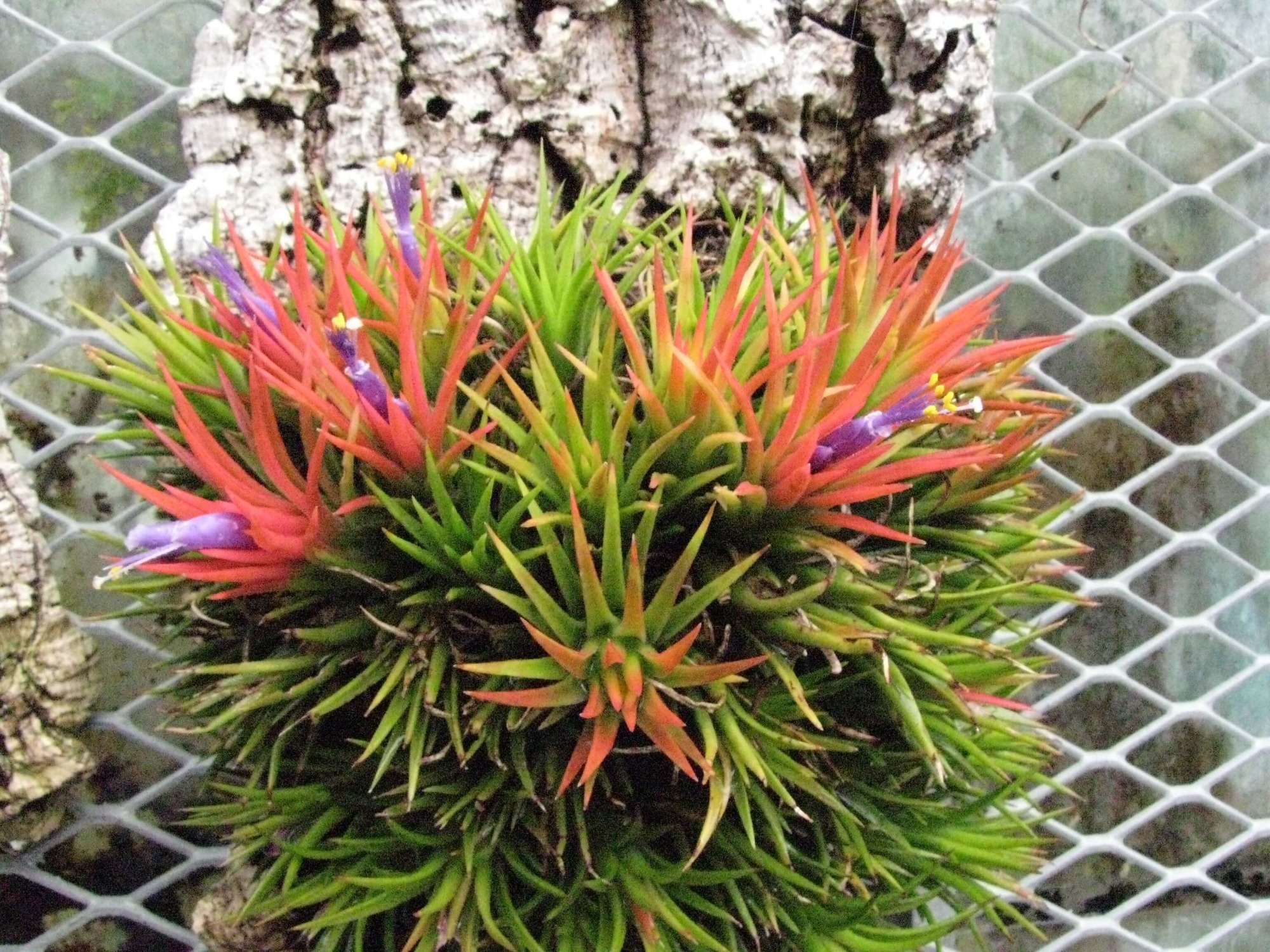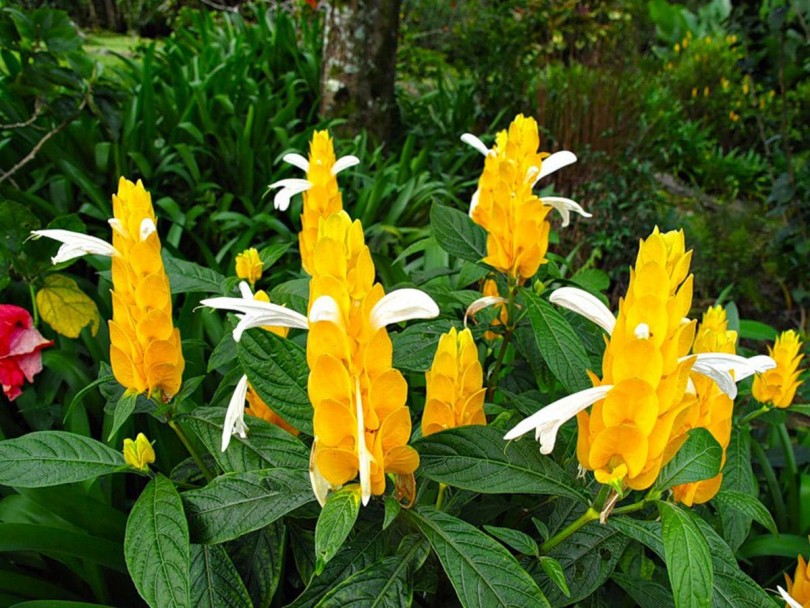Bougainvillea is a tropical flowering plant native to Brazil. It received its name in honor of the French navigator Louis Antoine de Bougainville. This shrub is widespread in home floriculture, due to a number of reasons: spectacular appearance, a high degree of adaptation to temperature extremes and unpretentious care. The long flowering period is also an advantage.
Content
What's interesting about this flower
The bougainvillea flower naturally grows in South and Central America, but is often found in other areas. So, the plant is actively cultivated in the Black Sea zone of Russia, Belarus and other regions with a temperate climate. The culture loves the sun, therefore it grows mainly on well-lit forest edges and mountain slopes.
The plant is a liana or a compact tree, but more often it appears as a shrub with flexible and long shoots up to 5 meters. They are completely covered with small thorns with which the vine clings to the support. With age, the branches become covered with tough bark. The leaves are oval and glossy. Bougainvillea flowers are small inflorescences with bright bracts.
Home bougainvillea blooms in May and pleases with its beauty until November. But in natural conditions, the plant blooms up to nine months a year. During this period, the leaves are completely hidden by large caps of flowers.
Views from photo
Bougainvillea belongs to the Niktaginov family, which is represented by more than 15 species. But few are suitable for indoor growing. The most common varieties of bougainvillea are naked and wonderful.
Varieties bred by breeding are distinguished by variegated leaves and multi-colored bracts.
The most popular types in home floriculture:
- Naked is an ornamental flowering shrub with creeping climbing shoots and sparse thorns. Small oval leaves with a smooth structure are evenly distributed along the branches. Flowers bloom at the tops.
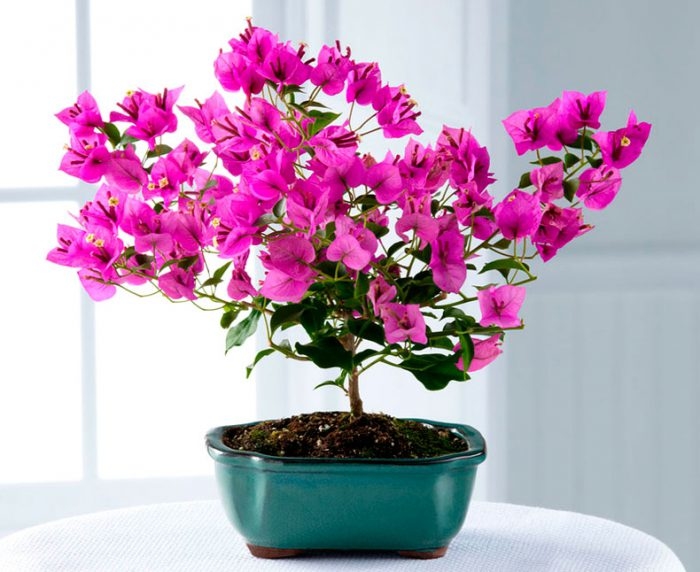
- Remarkable - a plant with a standing woody trunk, from which many intertwined branching branches depart. The leaves are bright green, lush. Flowering is profuse and long lasting.
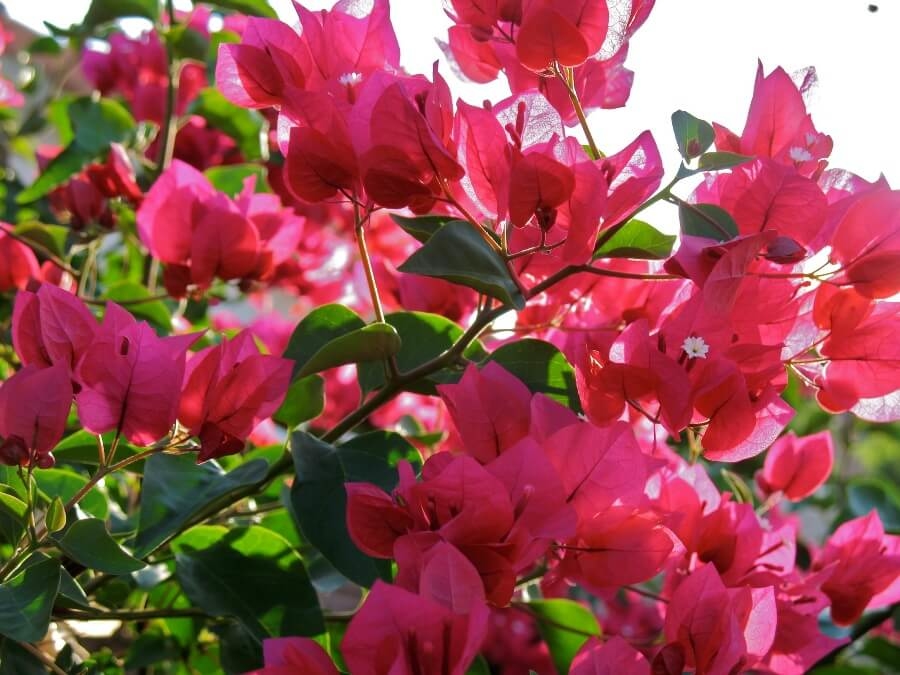
- Peruvian is a compact upright shrub with thorny branches, entirely covered with glossy green leaves. Inflorescences bloom singly or in groups of three.

Of the best decorative varieties, the following can be distinguished:
- Harris is a hybrid cultivar belonging to the naked bougainvillea. The leaves are deep green in color with clear cream veins.
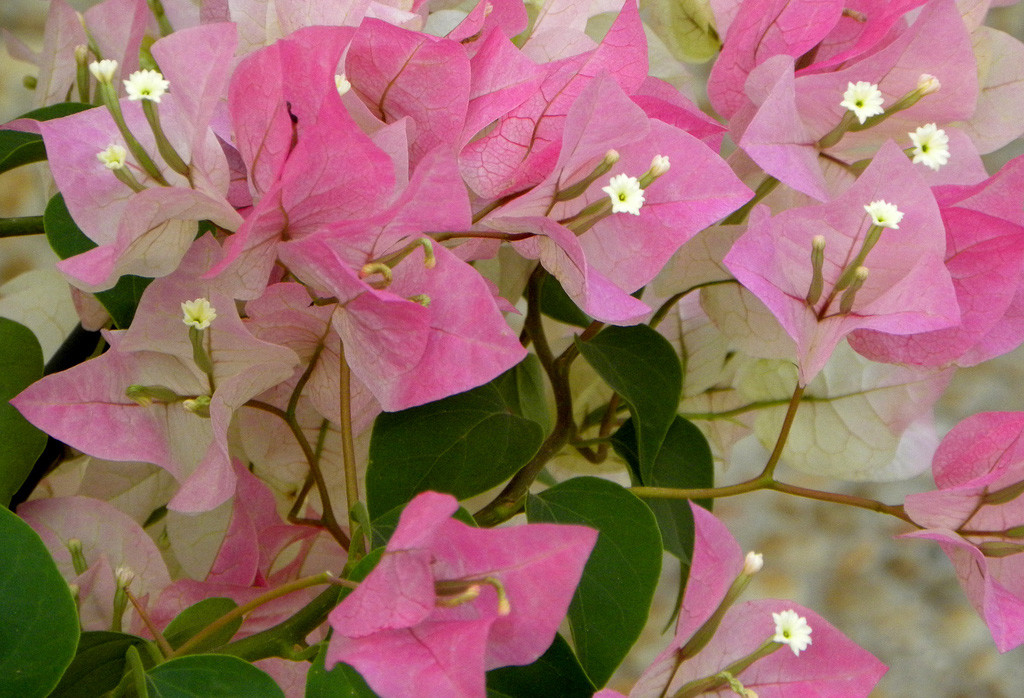
- Boisde roses are one of the most atypical representatives of bougainvillea, which is able to change the color of the bracts over time. At first they are orange, then dark pink and fade at the end of flowering.
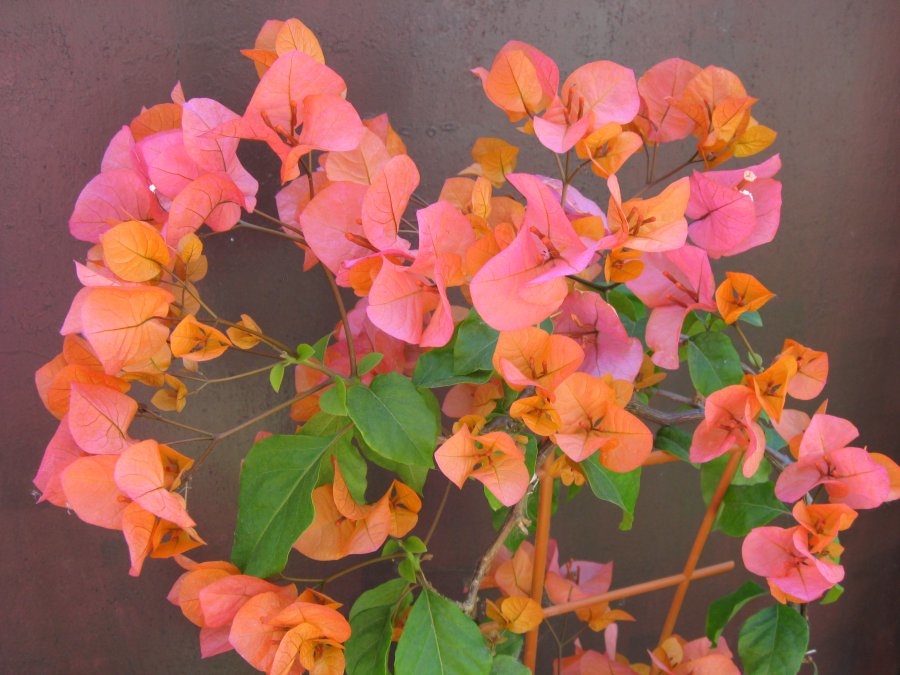
- Dauphine - stands out with red bracts in combination with multi-colored lush buds. Each petal has a specific pattern formed by a lighter border against the background of the main dark color.
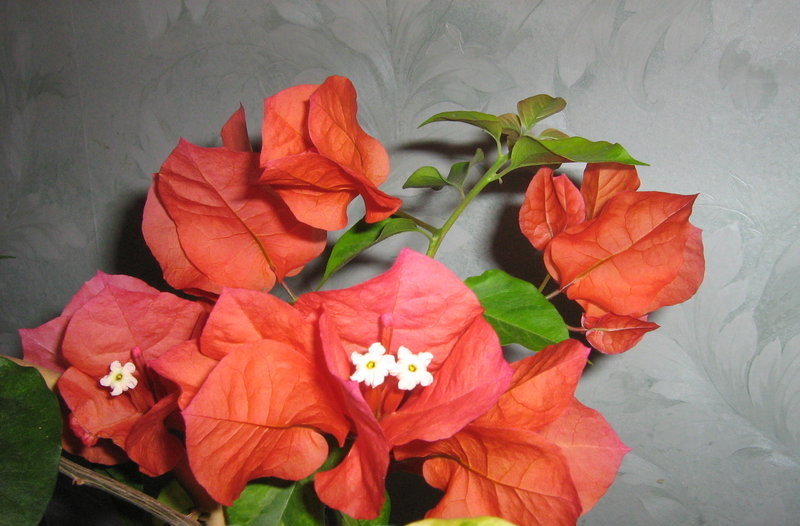
- Double Pink - blooms in double pink buds. The leaves of the plant are dark green and tough.
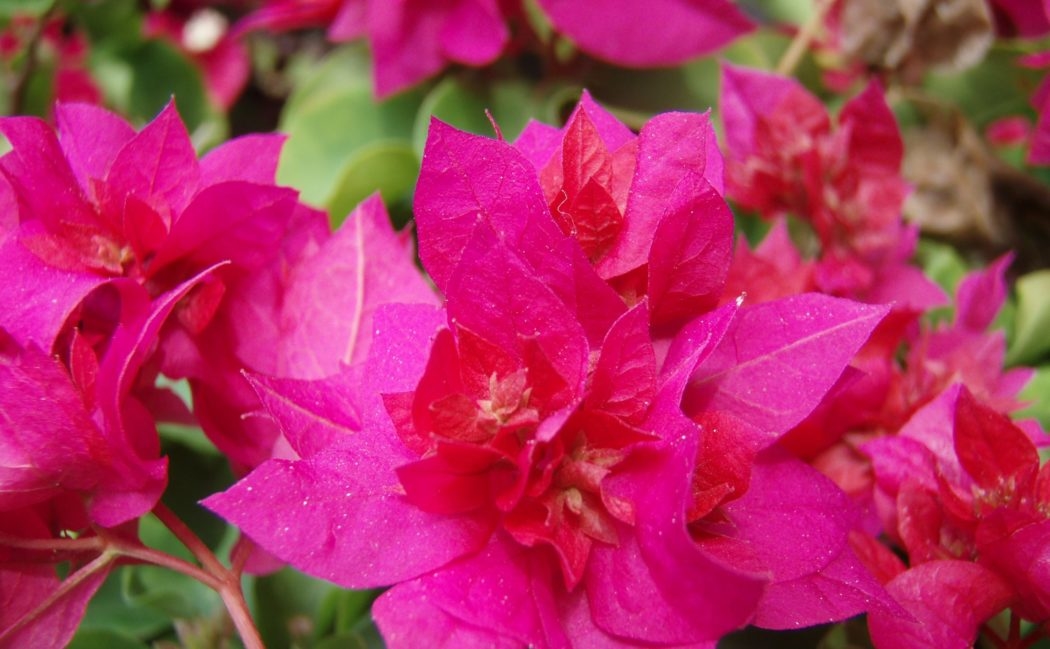
- Double Red - in comparison with other varieties, it blooms profusely with crimson flowers, the saturation of which remains throughout the growing season. The variety is terry.

- California Gold is a homemade bougainvillea with golden flowers that gradually fade and become almost creamy. Often the flower blooms in winter.
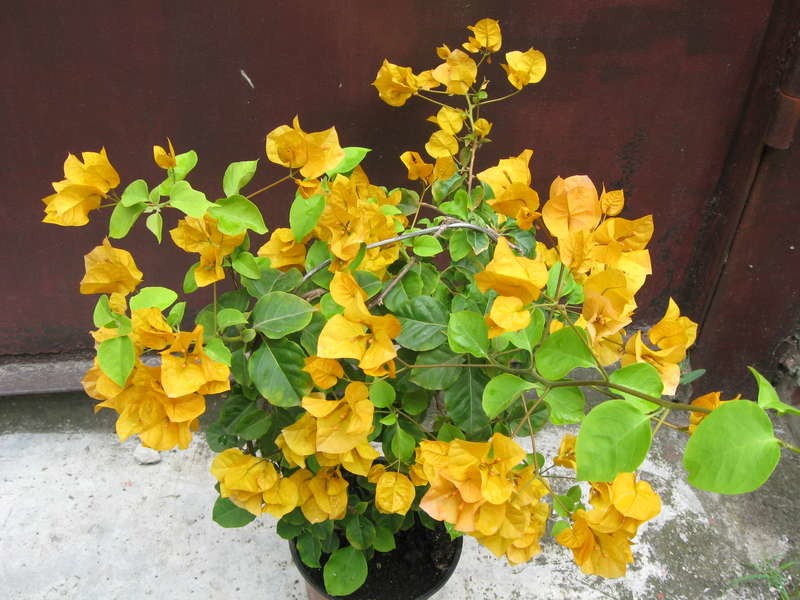
- White Cascade is a compact shrub with a compact crown. Its bracts are ivory-colored with a pinkish edging. The foliage is large, deep green in color.
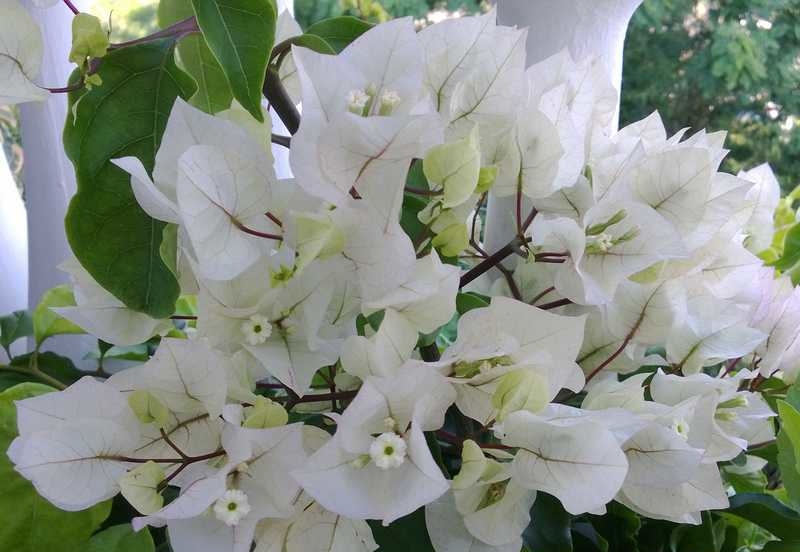
- Surprise is an unusual specimen, surprising with multi-colored bracts on one bush.
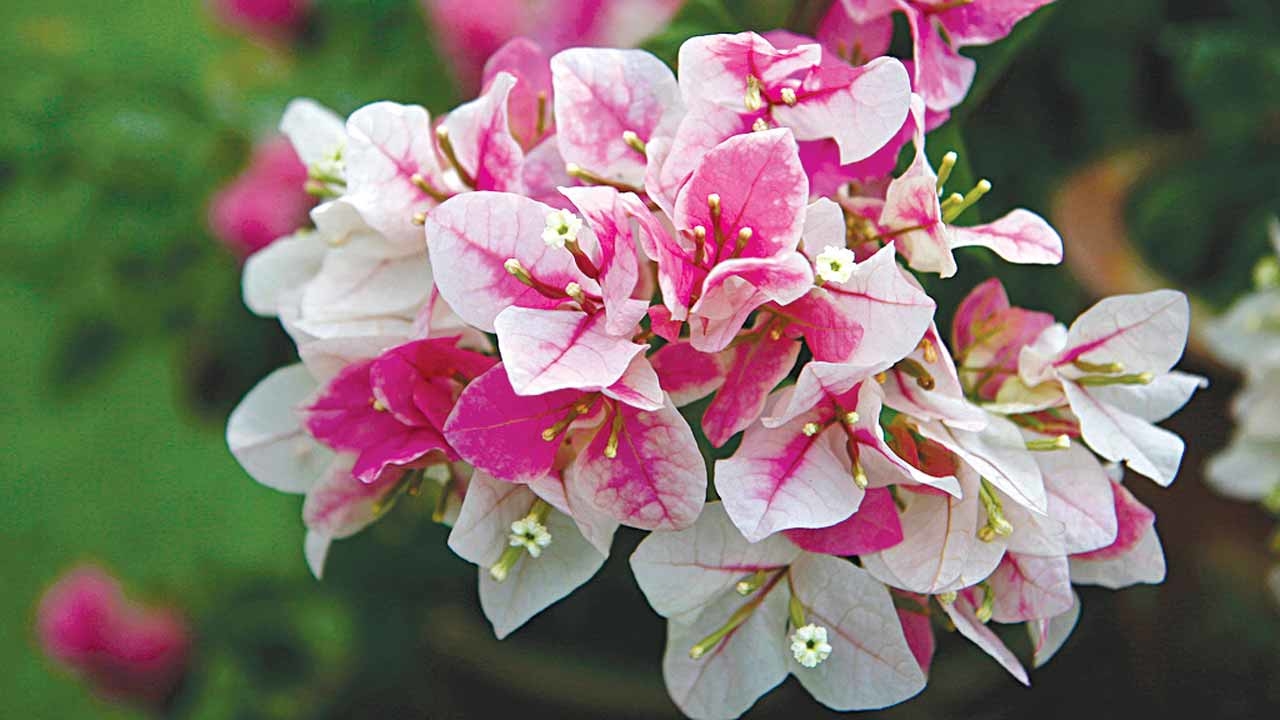
- Sanderiana is a hybrid based on naked bougainvillea. Popular for its lilac flowers, contrasting with rich emerald foliage.
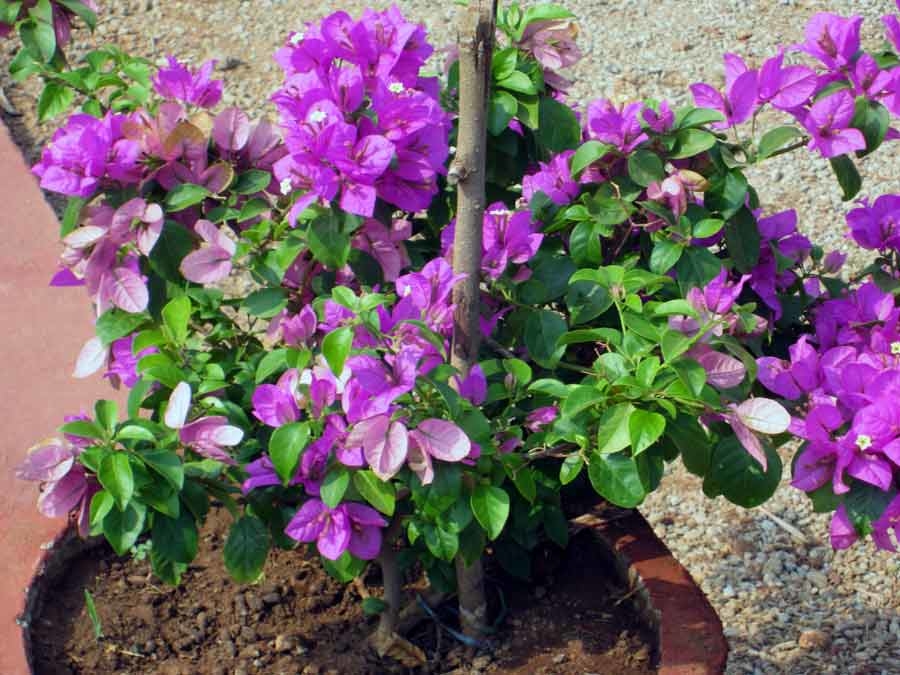
Optimal growing conditions
Bougainvillea as a tropical plant by origin loves a lot of light and warmth... In this regard, bougainvillea is often cultivated in greenhouses, where optimum humidity and temperature are constantly maintained. In the house, it is better to place the flower in places located near the south or west windows. This is the only way to grow lush-flowering specimens.
It is recommended to place the plant on glazed and insulated loggias in winter, and in the garden in summer. Comfortable temperature for growth - not lower than +5 ° C. Sufficient daylight hours are 5–6 hours.
With a lack of sunlight, the branches begin to stretch out strongly. This stops flowering.
Drafts are also unacceptable. So when airing, the plant is rearranged where the wind does not walk. Bougainvillea painfully endures a frequent change of place, so once again it should not be rearranged. If the new conditions turn out to be worse than the previous ones, then foliage and buds are discarded. From spring to autumn, the indoor temperature is kept at around 23–25 ° C. In winter, do not put a flower pot near heating appliances.
Landing
For planting, select small pots with a volume of 1.5 to 5 liters. In more spacious containers, the flower actively branches and forms greenery to the detriment of flowering. The soil can be mixed independently from garden soil and leaf compost with the inclusion of coarse sand. All components are taken in equal proportions. For the looseness of the composition, add vermiculite, expanded clay or broken clay shards (in total, no more than 10% of the volume of soil).
Drainage from small stones, pieces of foam or expanded clay is poured to the bottom. When planting, they try not to damage the roots, so they use the transshipment method - they capture the root ball along with the earth. Leave a distance between the walls of the pot and the root system of at least 3 cm. The remaining free space is filled with soil mixture.
It is permissible to apply a transplant no more than once every 3 years to old bushes and once every 2 years - for young ones.
How to care
Caring for bougainvillea at home means:
- Watering - in the warm season, it is carried out 2 times a week, but without stagnant water. After the procedure, the residues are drained from the pallet. Otherwise, the roots begin to rot, which inevitably leads to the death of the flower. In winter, the frequency of watering is reduced to a minimum, but the upper soil layer does not dry out. Usually one moisturizing is enough every 10-14 days.
- Top dressing - applied once a decade with alternating organic matter and complex additives. From May to August, it is recommended to fertilize with compounds with phosphorus and potassium, since nitrogen causes active lateral branching and inhibits flowering. During the dormant period, the plant is not fed.
- Spraying - do it every day in the summer, but so that drops do not fall on the buds. To increase air humidity, place a container with water next to it. You can place the pot on damp pebbles or moss.
- Pruning - important annually so that the bushes do not lose their decorative effect. To do this, cut the shoots in half in the fall. Thus, lateral branching is stimulated. In spring, it is recommended to cut loose, deformed and excess branches. And in the summer, young twigs are cut off immediately after flowering.Old branches are not touched, which is due to the inability to form living buds.
- Garter - necessary as the vines grow to create a beautiful crown.
Bougainvillea needs special care in winter. Since daylight hours are significantly reduced, the flower is rearranged to a more illuminated and cooler place. This will allow the plant to easily enter the dormant stage. Watering is stopped. Closer to spring, they begin to gradually increase the temperature in the room and gradually humidify.
Reproduction
Bougainvillea can be propagated in two ways: cuttings and layering. Growers prefer the first option more, since it is the most effective.
Cuttings
Homemade bougainvillea is mainly propagated by cuttings... After spring pruning, semi-lignified branches are taken and cuttings up to 15–20 cm long are harvested. Each requires 2–3 live ovaries. If propagated in summer, the tops of the branches are cut off.
Sequencing:
- The lower cut is made directly under the kidney.
- Process the bottom in any growth stimulant solution.
- A soil mixture is prepared from sphagnum moss, sand and coal chips. The harvested cuttings are buried in it at an angle of 45 degrees so that the lower 2 internodes are hidden.
- Then the plantings are placed in a warm place, the temperature should not fall below 22 ° C. You can cover the top with a glass or plastic cover to create a greenhouse effect. The lighting must be dim.
Further care consists in daily spraying and airing.
Layers
Reproduction by layering is less common among flower growers, since it is ineffective and labor-intensive.
Step-by-step instruction:
- Several long lashes are chosen, several circular cuts are made in the bark.
- Shoots are buried in a nearby groove.
- Top covered with fertile soil.
Young shoots will soon begin to sprout from the buds. As soon as the seedling is strong enough, it is cut off from the mother bush and planted in another place.
Possible growing problems
If the basic conditions for caring for bougainvillea are not followed, some problems in the growth process are possible.
- Stunted growth is too tight a pot. The plant is transplanted into a more spacious one.
- No flowering for a long period - not enough moisture and fresh air. It is necessary to adjust the watering regime and take the flower out into the garden or on an open balcony.
- Premature leaf fall - lack of light. Move the pot where there is enough light.
- Young leaves grow poorly - additional fertilizing with complex fertilizers is needed.
- Yellowing of foliage is an alarm signal about possible root rot. Water less often.
- The appearance of white spots on the leaf blades is the first symptom of mold. There are two ways out of this situation: airing and reducing the amount of humidification. As a preventive measure, it is necessary to treat the bushes with a fungicide or wipe the leaves with soapy water.
With the elimination of the deficiencies that have arisen, the growth and development of the plant will soon be restored.
Diseases and pests
When grown at home, the plant is particularly susceptible to insect damage. Commonly encountered:
- aphids;
- mealybug;
- spider mite.
Insects are localized mainly in the lower part of the leaves. They feed on plant sap, thereby weakening the growth of shoots. As a result, bougainvillea does not have enough energy to set the buds.
Common bougainvillea diseases and pests:
| Name | Symptoms | Treatment and prevention |
| Root rot | The tips of the branches turn black and dry. Leaves begin to crumble | Dry the soil and adjust the irrigation regime. If it does not help, then dig up and cut off the rotten roots. Then the sections are treated with crushed coal and the plant is transplanted into a fresh substrate. |
| Powdery mildew | On the leaf plates, a white coating is observed, which gradually turns into brown. If ignored, the stems are affected | The damaged leaves are removed, and the plant itself is powdered with sulfur powder.It is permissible to treat with fungicides: Fundazol, Bayleton. It is recommended to take the flower to fresh air for a while. |
| Chlorosis | The leaves lose their rich color and are covered with white specks | The flower is treated with phytoverm 1 time in 3-4 days. Periodic spraying with antichlorosin will serve as prevention. |
| Spider mite | The leaves turn yellow, fall off. The stem and petioles are entangled in a thin white web | The first step is to wash the plant under the shower, then place it in the cold (at a temperature of 6 to 15 ° C) for 2-3 hours. In spring and summer, the flower should be sprayed with insecticidal preparations once every 3 days (Kinmix, Admiral), and also systematically examined. To protect bougainvillea from mites, the air in the room is kept humid. |
| Aphid | New shoots, leaves and buds twist and die | The affected parts of the flower are cut off. They are treated with insecticides. Since pests enter healthy plants from new arrivals, it is advisable to keep the flowers in quarantine for some time after purchasing. |
| Mealybug | A sticky coating appears on the leaf plates and trunk. As a result, they shrink and die off. | Insecticidal preparations (actellik) help in the fight against insects. But first, the affected parts are removed, the rest are washed with warm water with shavings of laundry soap |
Bougainvillea is an unpretentious exotic plant that can bloom most of the year with proper care and optimal conditions. To do this, the soil is not allowed to dry out, top dressing is applied on time and the flower is regularly cut off.

